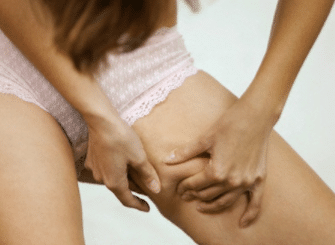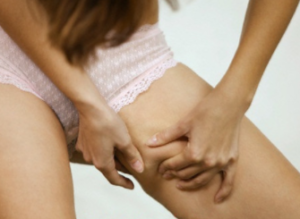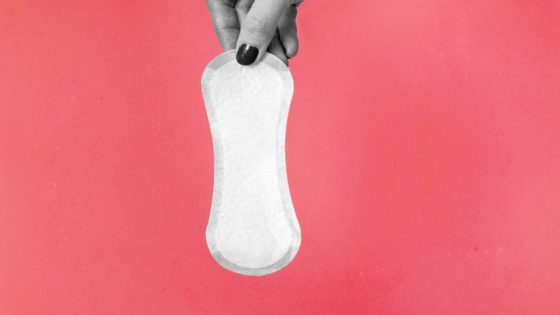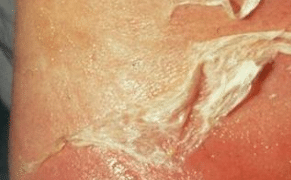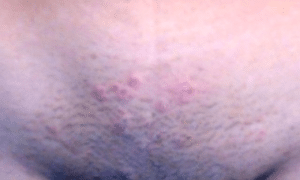Below is a detailed overview on boils on thighs capturing causes, types of boils, how to lance a boil on the inner thighs with no head and various treatments including home remedies. Also pictures have been provided to aid clear understanding.
Boils on Inner Thigh-Overview
According to America Academy of Dermatology [AAD], boils are also known as skin abscess or a pustule and it is a localized deep skin bacterial infection that appears as round, red pus filled, hard and painful lumps on the skin. It is caused due to the release of toxins in the body [or] entering the staphylococcus bacteria into a hair follicle [through cuts or scratches] or sweat glands, particularly on the area where it is exposed.
There are two types of boils Furuncle and carbuncles. Carbuncles are boils that occur in clusters or in multiples and are large in size and deeper. They take longer to heal and usually leave scars. The carbuncles usually have multiple heads at the tip of the bump. On the other hand furuncle are boils that occur singularly, they are usually smaller in size. Furuncles can also be referred to as deep folliculitis.
Boils can show up on thighs, groin, armpits, buttocks, genital organs or any other parts of your skin. The boil infection on your inner thighs can appear in different forms depending on what caused them. They can range in size from small bumps to large lumps. Also, the color of the boils can appear as red, pink, brown, yellow and whitish depending on the color of your skin.
In most cases boil infection begins with the formation of small red raised itchy spot in the affected area. The small bumps develop gradually into large pustules that are filled with pus. Once the bump on your skin is filled with pus, it causes the surrounding skin tissue to become inflamed and tender. This further leads to severe pain that can make you feel a discomfort.
Boils on Inner Thigh Causes
- Hidradenitis Suppurativa
This is an inflammation of the hair follicles and apocrine glands of the skin in the armpits, thighs, buttocks and other areas. The symptoms of this condition include skin becomes red, and then lumps of varying sizes from a pea to a walnut appear. They are very painful, red, hot and hard and within 3 days the bump become softer and may form pus.
- Staphylococcus aureus
This is type of bacteria that lives on the surface of the skin and inside the nasal cavity. It can also that can cause your skin to develop painful lumps. However, when the bacteria infect the hair follicles and oil glands on your skin, it leads to redness and inflammation and consequently formation pus resulting to a boils or a boil.
Staphylococcus bacteria are highly contagious and it can spread from the affected area of the skin to other parts of your body. This can happen when you try to puncture and squeeze the boil yourself by using fingers.
- Diabetes
According to America Academy of Dermatology ADD), people with diabetes tend to suffer from many skin conditions than people with normal blood sugar level, AAD also explain that diabetes type-2 tend to reduce flow of blood to the skin and can as well damage blood vessels and nerves a factor that in some great way change the skin texture, appearance and natural ability to heal. AAD further explains that you are prone to skin bacterial infections of all types (boils included) if it happens you have diabetes type 2.
- Poor Hair Removal Techniques
Waxing or shaving can also cause boils on inner thighs. Poor hair removal techniques and careless hair removal can cause cuts or minor injury to the skin putting you at risk of getting boils. Also if your hair follicles are infected, shaving can lead to infections causing boils on inner thighs. However, to reduce the chance of boils on inner thighs, avoid shaving too close to the skin and ensure you are shaving in the direction of hair growth.
- Excessive sweating and Obesity
According to mediscape.com, Obesity can increase the number of infection in the body including skin infections. Obesity results to friction or constant thigh rubbing a factor that results to boils on inner thighs. On the other hand, sweating can increase the risk of skin damage allowing staphylococcus bacteria to sprout on the cut skin, putting you at risk of getting boils on inner thighs.
- STDs
Sexually transmitted disease STD can also be the cause for upsurge of boils on inner thighs. Gonorrhea, genital herpes, genital warts and HIV are some of the STDs that might lead to painful bumps like boils on the private region as well as your inner thigh. If Boils on inner thighs develop after unprotected anal or vaginal sexual intercourse then it could be an indication of sexually transmitted infections and in such case it will advisable to visit your doctor for further directions and opinion.
- Ingrown Hairs
Boils on inner thighs may occur due to ingrown hairs, which are hair that curls or grows sideways inside hair follicle that further results to raised bumps on the surface of the skin. However, these bumps might get infected by bacteria staphi and advance to boils.
- Exposure to chemicals
Boils also appear when the skin is exposed to harsh chemicals. Strong chemicals such as those found in deodorant and other beauty care products irritate the skin and gives rise to boils on the skin surface.
- Pest
Boils though in rare circumstance can form after an insect bite. Tick bite is often seen to cause development of Furuncles over the bitten areas.
- Side effect of medication
Some over-the counter medications like corticosteroids suppress the immune system, thus making the body susceptible to bacterial infections and skin disorders, these consequently give rise to boils.
How to Lance a Boil on Inner Thigh no Head
A boil on inner thighs with no head is usually painful to touch and consequently hard to have it treated. In this case consider the following procedure.
- Soak a cotton wool with tea tree oil or lavender oil and use the same to cover up the boil.
- Apply honey on the area regularly.
- Rub a slice tomato or use tomato paste on the boil to quicken the boil’s opening up.
- Drizzle some lemon juice on a band aid and wrap the boil in it.
- After 24 hours, the boil should come to the head, open up and you will notice a yellow or white colored tip at the center where it opens up to drain the pus. Once this happen you will get instant relief.
- After the pus has completely drained out you can use sugar to pack the wound.
Boil on Inner Thigh Pictures
How to Get Rid of Boils on Inner Thigh-Remedy and Treatment
Below are various treatments and home remedies that have been used for quite a number of years to get rid and treat boils effectively.
TREATMENT
- In case of larger boils and serious infection Antibiotics are prescribed.
- Washing boils with antibiotic creams can make the boil to heal after a few days.
- Penicillin based medicines can also be administered for instance.
- In case of severe infection, skin abscesses a minor surgery can be perfomed.
Home remedies
Home remedies are usually used to get rid and treat small or medium sized boils. For people suffering from small sized boils Consider the following:
EPSOM SALT
Epsom salt is highly absorbent it helps to bring the pus in the boil to the head and speeds up drainage of bacteria. Epsom salt has ingredients that help to draw out toxins and impurities from the skin.
- Dissolve 6 tablespoon of Epsom salt to 2 cups of warm water.
- Dip a clean washcloth in the solution and place it over your boil.
- Leave it to sit for at least 30 minutes.
- Repeat this process as many times as possible until the boil drains completely.
- Alternatively, take a Sitz bath in warm water mixed with a cup of Epsom salt. Do this for 20 minutes, 3 times daily for 1 week.
NEEM/INDIAN LILAC
Neem is also known as Indian lilac or Margosa . it has ingredients that contain antibacterial and antiseptic properties. This makes it effective to cure boils on inner thighs.
Wash a handful leaves of neem tree and grind them into a paste.
- You can some peppermint oil.
- Apply this paste on the affected area and leave for sometimes at least 60 minutes. Rinse off the paste thereafter using distilled water.
- Repeat this process 3 times a day for 2 days to get rid of the boil.
- Alternatively, is to boil some neem leaves in water. Cool and strain the solution. Rinse the affected area with this neem-infused water as many times you can.
ONION
According to America Academy of Dermatology (AAD) onion has antiseptic and anti-microbial ingredients that fight skin infection and speed up the healing process. When onion juice comes in contact with the boil it is very irritating and by so doing it act as an antimicrobial agent. This helps to draw out the heat from the boil and promote bursting out. Onion also reduces inflammation and pain.
- Cut a fresh onion into thick slices.
- Place the onion slices over the boil and cover the area in a cotton wool.
- Change the onion slices after every 3 hours until the boil burst out and drains.
- Repeat this process the following day to avoid the boil from recurring.
- Alternatively, mix 1 teaspoon of honey in 1 teaspoon of fresh onion juice and apply it on the boil affected areas. Rinse off with lukewarm water after few minutes. Repeat it regularly.
TURMERIC
According to mediscape.com turmeric contains anti-inflammatory and antiseptic properties that help to speed up the healing process of your boil on inner thigh. Turmeric is also rich with a compound known as curcumin which help to relieve pain. Various researches have shown that Turmeric has blood purifying and detoxifying ingredients that clears itching and boost up your immunity.
- Make a thick paste of turmeric by mixing water and some turmeric powder. Alternatively, you can make a paste of turmeric by mixing turmeric powder, milk cream and vinegar.
- Using a cotton wool apply the turmeric powder on the boil and leave it on for 60 minutes. Cover the place with a cotton wool or bandage.
- Rinse of the boil with lukewarm water. Repeat this process after 2 a day. This will help the boil come to a head and burst within a few days.
WARM COMPRESS
According to a 2012 review article the fastest and easiest way to get rid of a boil on inner thighs is to use heat application. When you apply warm compress on a boil, blood circulation around the affected increases, this allows antibodies and white blood cells to fight the infection faster.
- Soak a cloth in warm water, squeeze out the excess water and press it over the boil.
- Do this repeatedly throughout the day until the boil burst out and pus drains out.
- Clean the area thoroughly and apply a medicated ointment to prevent any further infection or the boil from recurring
TEA TREE OIL
According to Better Health, Tea tree oil contain an ingredient known as terpinen-4-ol which exhibits strong anti-microbial, antiseptic and anti-inflammatory properties that suffocate and kill bacteria, hence relieving you from itching and reduces your pain to get rid of Boils.
- Dilute few drops of tea tree oil and Lavender oil in a bowl of warm water.
- Soak clean cotton in this mixture and place it over your boil.
- Leave it on for 30 minutes and rinse the boil with lukewarm water.
- Repeat the same process 5 times daily till the boil burst and drains out.
APPLE CIDER VINEGAR [ACV]
Apple cider vinegar (ACV) has many essential acids, nutrients and enzymes that break down the boil’s layer and penetrate deep into the skin to clear the problem from the root. It has anti-microbial, antiseptic and anti-inflammatory properties that help you to get relief from itching, pain and thereby infection.
- Add a few drops of apple cider vinegar (ACV) to water in a cup.
- Dip a cotton ball in this mix and dab it over the boils.
- Leave it on for few minutes and repeat the process as many times daily till the boil opens up and drains.
- Alternatively, mix equal parts of raw honey and organic apple cider vinegar (ACV). Apply it over the boil. Leave it to sit for 30 minutes then rinse it off with lukewarm water. Repeat this process 2 times daily tills the boil burst out and drains.
OR
- Mix equal parts of honey,( ACV) apple cider vinegar in a glass with lukewarm water.
- Stir it thoroughly to get relief from inside the body.
CALENDULA
Direct application of calendula over boils, either in herbal or in diluted form, can effectively reduce inflammation and pain in boils.
GOLDENSEAL
This herb has strong anti-bacterial properties that make it effective in fighting off bacterial infection and naturally curing the boils on your thighs.
- Create a paste of Goldenseal by mixing goldenseal root powder with lukewarm water.
- Stir thoroughly to mix well.
- Apply the paste over your boil and cover the place with a cotton wool for at least 60 minutes.
- Thereafter, rinse off the boil with lukewarm water and pat the boil dry.
MILK CREAM
Various researches have shown and considered milk cream an excellent poultice for boils. It helps soften the surface of the boil and so the head breaks draining out the boil.
- Apply some fresh milk cream on the boil.
- Leave it on for at least 60 minutes.
- Repeat daily until the boil heals.
OR
- Alternatively, mix equal parts of milk cream, white vinegar with some turmeric powder.
- Apply this paste on the boil,
- Leave it on for 60 minutes.
- Repeat this process as many times as you can. This will help speed up the healing process and reduce the chances of infection.
GARLIC
Garlic contains natural antibacterial properties. When applied over boil on thighs, the juice in garlic helps to ripen the boil so it opens up and the pus drains out.
To use Garlic:
- Smash 2 garlic cloves to extract the juice.
- Use a cotton pad to apply the juice on the boil.
- Leave it on for 60 minutes then rinse the boil with lukewarm water.
- Pat the affected area dry afterwards.
- Repeat the process once or twice a day.
OR
- Alternatively, you can make a paste from garlic juice and turmeric powder.
- Apply it on the boil and leave it on for 30 minute.
- Rinse the boil clean with distilled water and pat dry.
- Repeat this a few times a day.
- This will help control the infection and speed up healing process.
When to See a Doctor
In many cases boils clears up on their own or within a week, if there is no any complication. However when a boil becomes larger, infected and painful or accompanied by symptoms such as body aches, fever, chills and headache you need to see a doctor.
Any of these symptoms require immediate medical check-up because skin problems if left unattended to can spread to the blood stream and become life-threatening.
You doctor will carry out what is called incision and drainage [I&D]. This involves making a small nick ion the head of the boil to open it up and drain the pus. In some cases after the boil is drained out, gauze is used to pack the wound and if this occurs you are likely to return back to your doctor daily to change the gauze. Your doctor will also send some sample of the pus to the Laboratory Technician to help in identifying the type of bacteria causing your infection.
Also for larger boils with infections and abscesses, your doctor may order an ultrasound image of the infected area; this is to make sure that the pus in the boil is completely drained out. Your doctor may also recommend you for an ultrasound, if he suspects you have a boil under your skin that is not visible on the surface.
In case your doctor can’t conduct an Incision and Drainage [I&D] due to either where the boil is located or the size of the boil, your doctor may recommend you to see a surgeon. Your doctor may also prescribe intravenous antibiotics, ibuprofen or acetaminophen, which are also strongly recommended by American Academy of Dermatology [ADD]
FURTHER REFERENCES:


